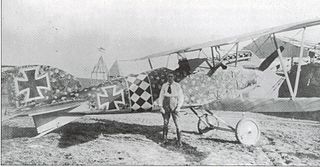Related Research Articles

Otto Kissenberth was a German flying ace of World War I credited with 20 aerial victories. He was a prewar mechanical engineer who joined the German air service in 1914. After being trained and after serving as a reconnaissance pilot, he became one of the first German fighter pilots, flying with Kampfeinsitzerkommando KEK Einsisheim. He scored six victories with this unit as it morphed into a fighter squadron, Jagdstaffel 16. His success brought him command of Jagdstaffel 23 on 4 August 1917. He would run his victory tally to 20, downing his final victim using a captured British Sopwith Camel on 20 May 1918. Nine days later, a crash while flying the Camel ended Kissenberth's combat career. His injuries were severe enough he was not returned to combat, instead being assigned to command Schleissheim's flying school. Although Otto Kissenberth survived the war, he died soon after in a mountaineering accident on 2 August 1919.

Walter Blume was a German fighter ace of World War I. During World War I, he flew with two fighter squadrons, Jagdstaffel 26 and Jagdstaffel 9 gaining 28 aerial victories and earning the Iron Cross, Royal House Order of Hohenzollern, and the Pour le Merite.

VizefeldwebelSebastian Festner was an air ace of the Luftstreitkräfte during World War I, with 12 victories. He was only the second awardee of the Member's Cross of the House Order of Hohenzollern.
StandartenführerLudwig Gaim was a World War I flying ace credited with five aerial victories. He ended the war as a Vizefeldwebel.
VizefeldwebelHermann Juhnke was a German World War I flying ace credited with five aerial victories.
VizefeldwebelAlfred Hübner was a World War I flying ace credited with six aerial victories.
Vizefeldwebel Max Kahlow was a German World War I flying ace credited with six aerial victories.

Karl Paul Schlegel was a German World War I flying ace credited with 22 victories. Schlegel was shot down by French ace Petar Marinovich. He was the last German ace to be killed in World War I.
OberleutnantHans Waldhausen was a World War I flying ace credited with six confirmed aerial victories in eight days. He was forced down and captured after his sixth victory.
Major Hermann Gilly was a World War I flying ace credited with seven aerial victories. He came to aviation service after two years infantry combat service, which saw him promoted to Leutnant in March 1916 while in Russia. He would not begin his flying career until November 1916. He served as an artillery cooperation pilot in Italy from November 1917 to March 1918. He was reassigned to a fighter unit, Jagdstaffel 40, effective 14 April 1918. Gilly scored seven aerial victories from 24 May 1918 through war's end. He was discharged on 22 January 1919.
VizefeldwebelGustav Schneidewind was a World War I flying ace credited with seven aerial victories.
Major Karl Waldemar Ritscherle was a World War I flying ace credited with eight aerial victories. He served again in the World War II Luftwaffe, and was killed in action when his Heinkel 111 was shot down and fell into Abberton Reservoir.

VizefeldwebelFritz John Jacobsen was a German World War I flying ace credited with eight confirmed and two unconfirmed aerial victories.
VizefeldwebelMichael Hutterer MMC IC was a World War I flying ace credited with eight aerial victories.
Leutnant Heinrich Henkel was a World War I flying ace credited with eight aerial victories.
Leutnant Wolfgang Güttler was a World War I flying ace credited with eight aerial victories. He would score the first four while flying with Jagdstaffel 24, and the last four while flying as commander of Jagdstaffel 13. He was killed in a midair collision over his home airfield on 20 February 1918.
VizefeldwebelEmil Schäpe was a German World War I flying ace credited with 18 aerial victories.
Hans Joachim Rolfes was a German World War I flying ace credited with 17 confirmed and two unconfirmed aerial victories. He scored his first confirmed victory while with Royal Bavarian Jagdstaffel 32, on 6 July 1917. His second and subsequent victories were while leading Royal Prussian Jagdstaffel 45 during the first nine months of 1918. On 29 September 1918, he was additionally given command of a four squadron wing. Rolfes died in an aviation accident on 12 August 1935.
LeutnantKarl Odebrett was a German World War I flying ace credited with 16 aerial victories.

Willy Rosenstein, Iron Cross, was a German flying ace in World War I, credited with 9 victories.
References
- Franks, Norman; Bailey, Frank W.; Guest, Russell. Above the Lines: The Aces and Fighter Units of the German Air Service, Naval Air Service and Flanders Marine Corps, 1914–1918. Grub Street, 1993. ISBN 0-948817-73-9, ISBN 978-0-948817-73-1.